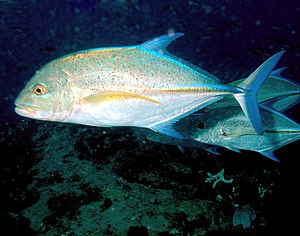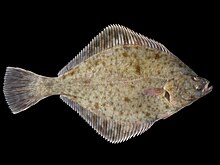Mackerel relatives
| Mackerel relatives | ||||||||||||
|---|---|---|---|---|---|---|---|---|---|---|---|---|

Bluefin mackerel ( Caranx melampygus ) |
||||||||||||
| Systematics | ||||||||||||
|
||||||||||||
| Scientific name | ||||||||||||
| Carangoidei | ||||||||||||
| Jordan , 1923 |
The mackerel relatives (Carangoidei) are a bone fish taxon from the group of perch relatives (Percomorpha).
features
Two synapomorphies are given for the group : One or two tubular ossifications (prenasals) as an extension of the nasals , a feature that they share with the archer fish (Toxotidae), and small, connected round scales .
All mackerel relatives are medium-sized to large, mostly very fast predatory fish and reach lengths between 22 cm and 2.5 m. They can be slender and spindle-shaped or high-backed and strongly flattened on the sides. All species of the mackerel relatives live in the sea, especially in the tropics and subtropics, and feed on carnivore .
Internal system

The mackerel relatives consist of four families, the eponymous jacks (Carangidae), with about 32 genera and over 140 species, as well as the ship keepers (Echeneidae) to which four genera and eight species belong, the golden mackerel (Coryphaenidae) with two species, and the monotypical Cobias family (Rachycentridae). The last three families are combined to form the superfamily Echeneoidea. The jacks themselves are paraphyletic because two of the four subfamilies are more closely related to the Echeneoidea than to the other two subfamilies of the Carangidae.
| Cladogram of the jack mackerel relatives: | |||||||||||||||||||||||||||||||||||||||
|---|---|---|---|---|---|---|---|---|---|---|---|---|---|---|---|---|---|---|---|---|---|---|---|---|---|---|---|---|---|---|---|---|---|---|---|---|---|---|---|
|
External system
The mackerel relatives belong to the perch relatives (Percomorpha) and were led as the superfamily Carangoidei, or in Nelson simply as the Carangoide line in the order of the old paraphyletic perch-like (Perciformes). Among the closest relatives of Jack Fish relatives belong to different cladistic some families in the subordination of the investigations Real perch were performed (Percoidei) ( centropomidae , latidae (Latidae), Moon perch (Menidae), threadfin (Polynemidae), archer fish (Toxotidae)) as well as the barracudas (Sphyraenidae) and the swordfish-like (Xiphioidea). The flatfish , whose close relationship with some "Perciformes" has long been suspected, are also related.
In a revision published in May 2020, all of these taxa are placed in the Carangiformes order named after the jacks .
supporting documents
- ↑ German name after: WE Engelmann: zoo animal keeping 5. Fish. , Page 639-640, German Harri GmbH, 2005, ISBN 3-8171-1352-8
- ↑ a b c d Matthew G. Girard, Matthew P. Davis, W. Leo Smith: The Phylogeny of Carangiform Fishes: Morphological and Genomic Investigations of a New Fish Clade. Copeia, 108 (2): 265-298 (2020). doi: 10.1643 / CI-19-320
- ^ EO Wiley & G. David Johnson: A teleost classification based on monophyletic groups. Joseph S. Nelson , Hans-Peter Schultze & Mark VH Wilson: Origin and Phylogenetic Interrelationships of Teleosts. 2010, Verlag Dr. Friedrich Pfeil, Munich, ISBN 978-3-89937-107-9
- ^ Joseph S. Nelson : Fishes of the World , John Wiley & Sons, 2006, ISBN 0-471-25031-7 , p. 360.
- ↑ Blaise Li, Agnès Dettaï, Corinne Cruaud, Arnaud Couloux, Martine Desoutter-Meniger, Guillaume Lecointre: RNF213, a new nuclear marker for acanthomorph phylogeny. Molecular Phylogenetics and Evolution, Volume 50, Issue 2, February 2009, Pages 345-363 doi : 10.1016 / j.ympev.2008.11.013
- ↑ Alexander Little, Stephen C. Lougheed, Christopher D. Moyes: Evolutionary affinity of billfishes (Xiphiidae and Istiophoridae) and flatfishes (Pleuronectiformes): Independent and trans-subordinal origins of endothermy in teleost fishes. Molecular Phylogenetics and Evolution, Volume 56, Issue 3, September 2010, Pages 897-904 doi : 10.1016 / j.ympev.2010.04.022
- ↑ Bruce O'Toole: Phylogeny of the species of the superfamily Echeneoidea (Perciformes: Carangoidei: Echeneidae, Rachycentridae, and Coryphaenidae), with an interpretation of echeneid hitchhiking behavior. Can. J. Zool. 80 (4): 596-623 (2002) doi : 10.1139 / z02-031
